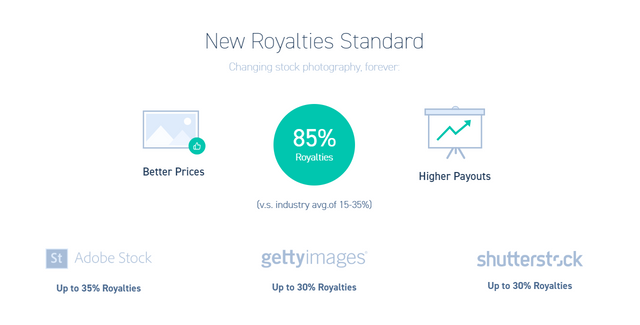Traditional stock photography in comparison to the blockchain one – WeMark
Undoubtedly there is a crisis in professional photography. Mass adoption of high-quality photographic equipment and a growing number of people who can handle it caused the price drop. Stock agencies were created as one of the solutions for the photographers how to still gain some profits from their work. Although, they don’t fully cover the market needs. Is there enough space for another player?
History
Everything began in 1920 when first stock photography agencies appeared on the market. One of the stock photo pioneers was the American photographer H. Armstrong Roberts who gathered 6 people in front of the plane and took the iconic image “Group in Front of Tri-Motor Airplane”. That was the beginning of stock pictures we know today. Another part of historical stock images came from The Bettman Archive, a great collection created by Otto Bettman which started with 15 000 photos. Later on, different photographers were adding their pics to this collection. The archive was bought in 1995 by the Bill Gates-owned Corbis Corporation. By that time the collection consisted of 16 million images, “the visual history of everything” and what is sad the great share of them got restricted.
Another of the immense stock agencies, Getty Images appeared in 1995. Jonathan Klein and Mark Getty started from offering a mix of Rights Managed and Royalty-Free Images available for download and on CD ROM and slowly started to buy up smaller agencies. Getty and Corbis belong to the category of macrostock and midstock photography and what about the last kind – microstocks?
What makes microstocks different is a low price per one picture, what helps in mass buying by small companies or blog owners. One of the most first microstocks appearing on the market was “iStock” with a very affordable price per picture - from a few cents to $10. Later on, other microstocks were following this path like Shutterstock for example. Jon Oringer, who founded the company in 2003 had just an idea and an $800 camera. With half a year he made 30 000 pictures of everything around him. In next couple years, this number grew to 20 million photographs from 35,000 approved image-contributors. Shutterstock's market cap was recently more than $760 million.
Microstocks movement in years became very similar to Getty and Corbis. Mainly because of the increasing the price of a picture as well as charging a great share of the photographer income. This burst out into the photographers and buyers protests.
Introducing blockchain into this scheme and thereby eliminating middleman is one of the possible ways to modify this market. And the game is worth the playing as a leading global market research company, Technavio concluded that global still image will exceed USD 4 billion by 2020 with the annual growth rate of over 7%.
Differences:
Middleman:
WeMark has been invented as a stock marketplace with no middleman. It means that photographers or designers license content directly to customers, keeping a track who bought their content and for which price. So instead of working like photography agency its more like the p2p marketplace.
Royalities:
For today, the photographers cooperating with stock companies like shutterstock or gettyimages can get up to 30% of the royalties. Slightly better the situation looks with Adobe Stock – 35%. WeMark offers 85% of royalties for the photographer. That is why in a very short period of time 1 000 000 of pictures has been uploaded on the WeMark platform. As I wrote before all because of the blockchain functionality which allows:
• Accepting payments
• Licensing content on behalf of the creator
• Providing access to the content
• Rewarding content marketplaces and referrals for promoting the content
• Rewarding the content’s creator
Payments:
In the traditional stock,s payment can be made with fiat money. WeMark allows to make it with cryptocurrency (WMK token) as well as ETH, BTC and fiat.
Content:
Stocks like Getty or Shutterstocks contains just pictures. WeMark wants to present all creative content like graphics, videos, 3d models and music in the nearest future (beginning of 2019).
If you would like to learn more about WeMark check the links below:
Website: https://tge.wemark.com/
Whitepaper: https://www.wemark.com/whitepaper.pdf
Social media:
Telegram: https://t.me/wemark
Twitter: https://twitter.com/_wemark
Facebook: https://www.facebook.com/WemarkOfficial/
Disclaimer: this is NOT investment advice. This is purely our opinion, based on facts found on the project website, whitepaper, social media and etc. Please do your own research and decide if it qualifies with your risk profile.


Congratulations @annahare! You have completed the following achievement on Steemit and have been rewarded with new badge(s) :
Click on the badge to view your Board of Honor.
If you no longer want to receive notifications, reply to this comment with the word
STOPTo support your work, I also upvoted your post!